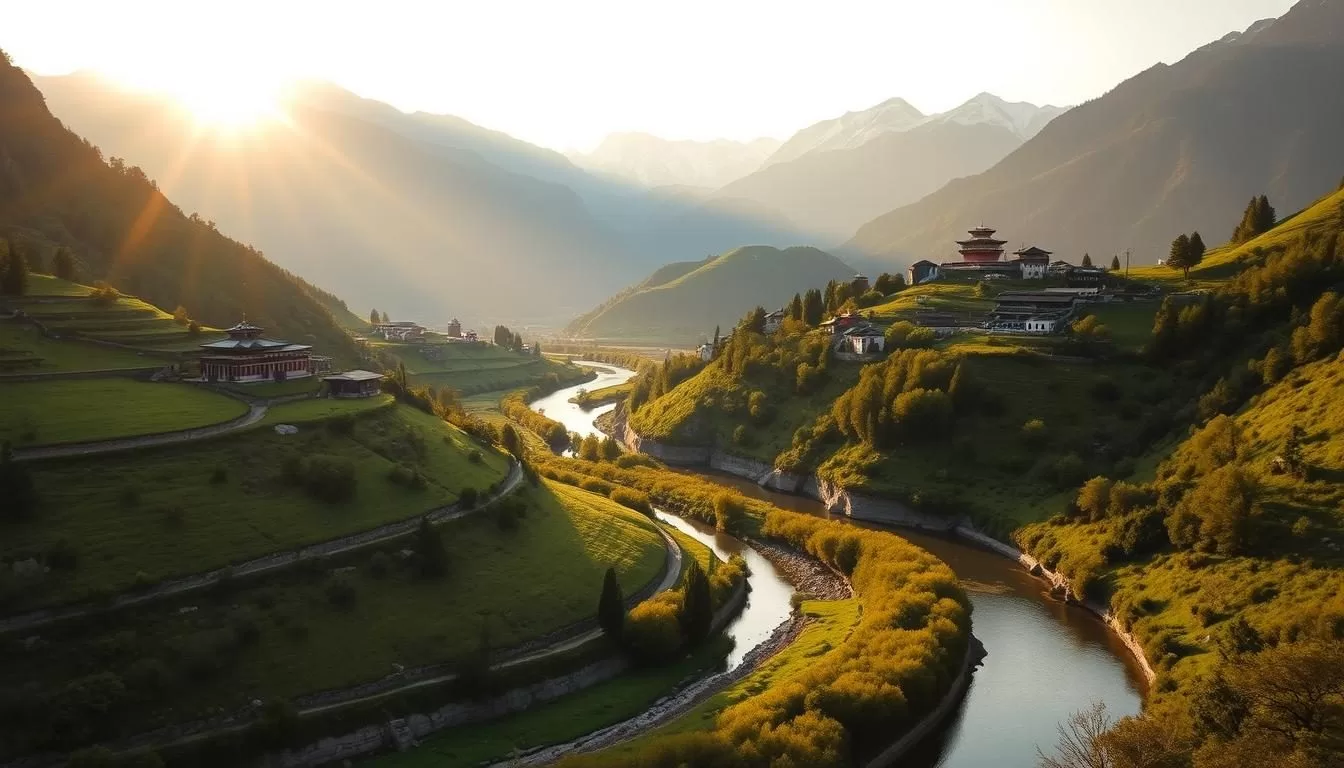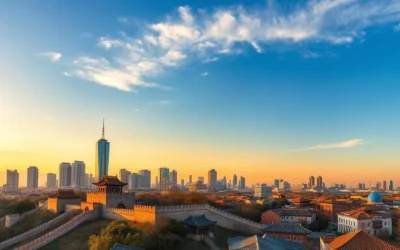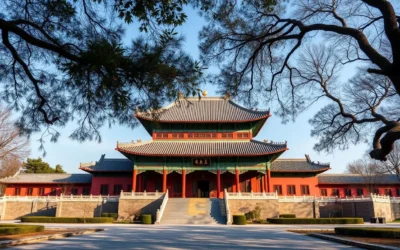✓ Accommodations✓ Flights✓ Rental Cars
When planning a trip, choosing the right time can make all the difference. Understanding the local climate and seasonal attractions ensures a seamless and enjoyable experience. Whether you’re exploring vibrant cities or serene landscapes, timing your visit well allows you to make the most of your day.
Spring and autumn are often considered the ideal seasons for travel, offering pleasant weather and fewer crowds. These periods provide the perfect balance for outdoor activities and sightseeing. By aligning your trip with the best time to visit, you can enjoy everything your destination has to offer without unnecessary stress.
This guide will help you navigate seasonal temperatures, local climate variations, and what to expect during different periods. Get ready to plan your weather-savvy adventure and create unforgettable memories!
Introduction to Sichuan’s Unique Climate
Exploring this area requires a good grasp of its unique climate. The region’s weather is shaped by its diverse geography, including mountains and basins. These features create distinct microclimates that vary throughout the year.
Geographical Influences on Weather Patterns
The terrain plays a major role in shaping local weather. High-altitude areas experience cooler temperatures, while lower basins are warmer. For example, the average annual temperature in Jinzhuzhen is 4 degrees Celsius (39 degrees Fahrenheit). This diversity makes packing and planning essential for your trip.
Overview of the Region’s Four Seasons
The area experiences four distinct seasons, each offering unique travel opportunities. Spring brings mild weather and blooming landscapes, ideal for outdoor activities. Summer is warmer but often accompanied by rain, while autumn offers crisp air and vibrant foliage. Winters are generally mild, with occasional snowfall in higher elevations.
| Season | Weather Characteristics |
|---|---|
| Spring | Mild temperatures, blooming flowers |
| Summer | Warm with frequent rain |
| Autumn | Crisp air, colorful foliage |
| Winter | Mild with occasional snow |
Understanding these patterns helps you choose the right month for your visit. Whether you’re hiking in the mountains or exploring cultural sites, timing is everything.
Sichuan Province, China: Best Months for a Weather-Savvy Trip
Timing your visit to this region can significantly enhance your experience. The area boasts diverse microclimates, making it essential to choose the right month for your trip. Understanding local temperature trends ensures you’re prepared for the weather conditions you’ll encounter.
For example, in Chengdu, the average temperature in July reaches 86°F (30°C), while January averages 48°F (9°C). These variations highlight the importance of planning your visit during milder months. Spring and autumn are often ideal, offering comfortable conditions for exploring.
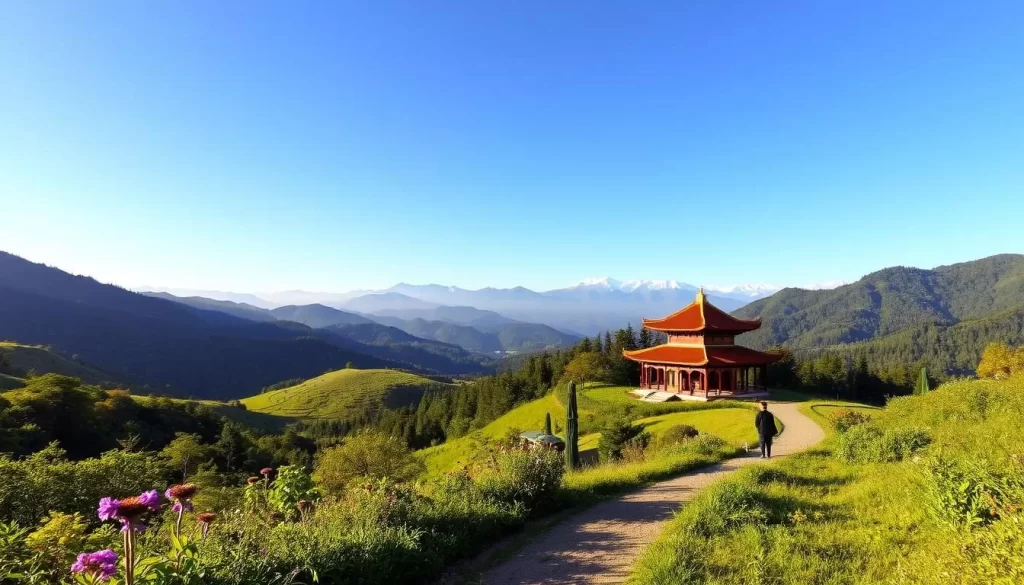
In higher-altitude areas like Jiuzhaigou, summers are cooler, while winters can be extreme. This contrast underscores the need to align your travel dates with the specific area you plan to visit. By doing so, you’ll avoid discomfort and make the most of your trip.
Here’s a quick comparison of temperature trends across the region:
- Spring: Mild and pleasant, perfect for outdoor activities.
- Summer: Warm and humid, with frequent rain in some areas.
- Autumn: Crisp air and vibrant foliage, ideal for sightseeing.
- Winter: Mild in lower elevations, colder in high-altitude regions.
Aligning your travel plans with these seasonal patterns ensures a smoother and more enjoyable journey. Whether you’re exploring bustling cities or serene landscapes, timing is everything.
Spring in Sichuan: Temperate and Beautiful
Spring is a magical time to explore this region, with mild weather and vibrant landscapes. The season brings blooming flowers and comfortable temperatures, making it ideal for outdoor adventures. Whether you’re strolling through markets or hiking scenic valleys, spring offers a refreshing escape.
Weather Overview and Temperature Trends
During spring, temperatures range from 50°F to 70°F (10°C to 21°C), creating a pleasant environment for exploration. Higher-altitude areas may still feel cooler, while lower regions enjoy milder conditions. Rainfall is moderate, so it’s wise to pack a light rain jacket.
In March, southern areas bloom with rapeseed flowers, while high-altitude spots remain chilly. By April, the weather stabilizes, offering clear skies and comfortable days. This makes it a great time for outdoor activities like hiking and sightseeing.
Tips for Packing Light and Breathable Layers
Packing for spring travel is all about versatility. Lightweight clothing and breathable layers are essential. Here’s a quick guide:
- Light Jacket: Perfect for cooler mornings or evenings.
- Breathable Shirts: Keep you comfortable during warmer afternoons.
- Waterproof Shoes: Ideal for occasional rain showers.
Layering allows you to adapt to changing temperatures throughout the day. Don’t forget a compact umbrella or raincoat for unexpected showers.
Spring is also a low-peak period for tourists, offering a more personalized travel experience. You’ll have more space to enjoy popular attractions without the crowds. Whether you’re exploring bustling cities or serene landscapes, spring is the perfect time to visit.
Summer in Sichuan: Navigating the Rainy Season and Heat
Summer in this region offers a mix of vibrant energy and weather challenges. The season brings warmth, occasional rain, and high humidity, making it essential to plan your activities wisely. Understanding the local climate patterns ensures you’re prepared for a comfortable and enjoyable trip.
Managing Humidity and Seasonal Rain
Summer humidity can be intense, especially in lower-altitude areas. Temperatures often reach 87°F (30.5°C), with humidity levels around 74%. The rainy season adds another layer of complexity, with frequent showers and occasional heavy downpours. To stay comfortable, pack light, breathable clothing and a compact umbrella.
Here are some practical tips for handling the weather:
- Stay Hydrated: Carry a reusable water bottle to combat the heat.
- Layer Wisely: Wear moisture-wicking fabrics to manage sweat.
- Plan for Rain: Keep a lightweight rain jacket or poncho handy.
Top Activities and Attractions to Enjoy Despite the Heat
Despite the weather, summer is a great time to explore the region’s vibrant culture and natural beauty. Early mornings and late afternoons are the best time visit popular outdoor sites, as the heat is less intense. Indoor attractions, such as museums and tea houses, provide a refreshing escape during midday.
Here’s a list of activities to consider:
- Visit Temples: Explore historic sites with shaded areas.
- Enjoy Local Cuisine: Savor cold dishes and refreshing drinks.
- Take a Scenic Drive: Discover breathtaking landscapes in cooler hours.
| Activity | Best Time Visit |
|---|---|
| Hiking | Early morning or late afternoon |
| City Tours | Mid-morning or early evening |
| Indoor Museums | Midday |
By planning your time visit strategically, you can make the most of your summer adventure. Whether you’re exploring bustling markets or serene landscapes, these tips ensure a memorable experience.
Autumn in Sichuan: Ideal Conditions and Fall Colors
Autumn transforms the region into a breathtaking canvas of colors and cultural vibrancy. The season brings cooler temperatures, making it the perfect time for outdoor exploration. With mild weather and fewer crowds, you can fully immerse yourself in the area’s natural beauty.
Enjoying Mild Weather and Scenic Landscapes
During autumn, temperatures range from 50°F to 68°F (10°C to 20°C), creating a comfortable environment for sightseeing. The valleys, traditional villages, and rolling hills come alive with vibrant foliage, offering endless photo opportunities. Early November is the best time to witness the peak of fall colors before colder weather sets in.
Here are some must-see locations for autumn scenery:
- Valleys: Explore lush landscapes filled with golden and red hues.
- Traditional Villages: Experience the charm of rural life surrounded by nature.
- Rolling Hills: Hike through picturesque trails with panoramic views.
Cultural Festivals and Outdoor Experiences
Autumn is also a time for cultural celebrations. The Lhabab Duchen festival, held in mid-November, honors Buddhist traditions and attracts visitors from across the region. Additionally, food tours and harvest festivals allow you to savor local flavors and traditions.
Here are some activities to enjoy during this season:
- Hiking: Discover scenic trails with comfortable temperatures.
- Photography: Capture the stunning fall colors and cultural events.
- Food Tours: Taste seasonal dishes and local specialties.
By planning your visit during autumn, you’ll experience the region’s natural beauty and cultural depth at their finest. Whether you’re hiking through colorful landscapes or attending festive events, this season offers unforgettable memories.
Winter in Sichuan: Mild Winters and Unique Experiences
Winter in this region offers a unique blend of mild weather and cultural charm. Unlike other parts of the country, the colder months here are relatively gentle, with average temperatures ranging from 5°C to 15°C (41°F to 59°F). This makes it an ideal time to explore without the extreme chill found elsewhere.
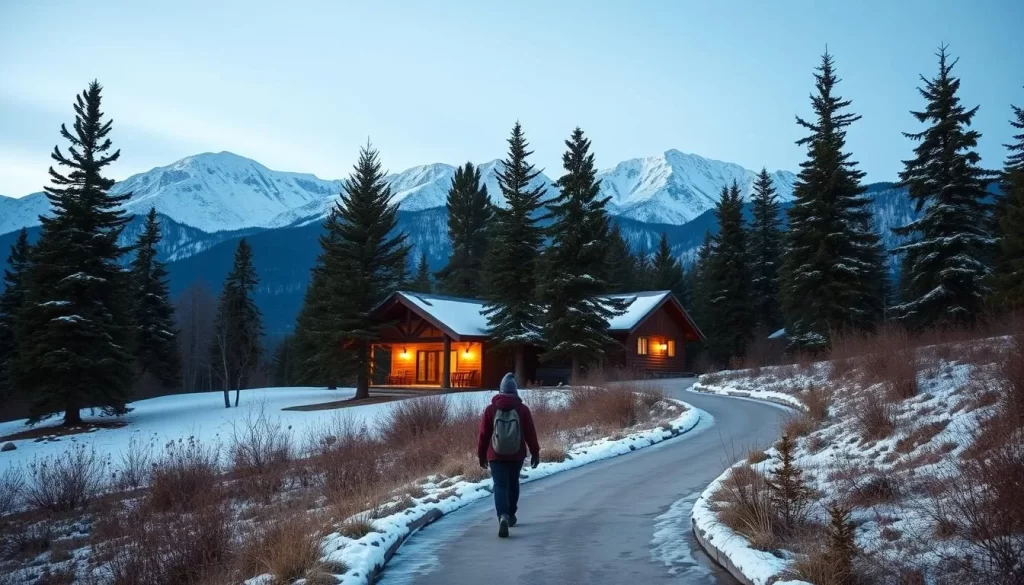
While the season is milder, thoughtful packing is still essential. Layering is key to staying comfortable during chilly mornings and evenings. A lightweight jacket, thermal layers, and a scarf can make all the difference. Don’t forget waterproof shoes for occasional drizzly days, as winter rainfall averages around 30-50 mm per month.
Layering Tips and Staying Warm in Cooler Weather
To stay warm and comfortable, follow these layering techniques:
- Base Layer: Opt for moisture-wicking fabrics to keep dry.
- Mid Layer: Add a fleece or sweater for insulation.
- Outer Layer: Choose a windproof and waterproof jacket.
This approach allows you to adapt to changing temperatures throughout the day. A compact umbrella or raincoat is also handy for unexpected drizzle.
Winter is also a great time to enjoy unique experiences with fewer crowds. Tourist numbers drop, giving you more space to explore popular attractions. Indoor activities, like visiting museums or savoring hot pot, are particularly enjoyable during this season.
Here are some activities to consider:
- Hot Springs: Relax in natural thermal baths.
- Cultural Tours: Explore historic sites and local markets.
- Regional Festivals: Experience traditional celebrations.
By planning your visit during winter, you’ll discover a quieter, more intimate side of the place. Whether you’re soaking in hot springs or exploring cultural landmarks, the season offers unforgettable memories.
Regional Climate Variations Across Sichuan
Understanding regional climate differences is key to planning a successful trip. The area’s diverse geography creates unique weather patterns that vary significantly between highland and basin regions. These variations can impact everything from your packing list to your daily activities, making it essential to plan accordingly.
Highland Areas Versus Basin Climates
High-altitude regions, such as Emei Shan, experience cooler temperatures year-round, with winter averages dropping below freezing. In contrast, the fertile Red Basin enjoys milder conditions, allowing for multiple harvests annually. This stark contrast means you’ll need to adjust your itinerary based on the specific areas you plan to visit.
Monsoon influences also play a significant role, particularly in the south. During the rainy period, this region sees frequent showers and high humidity, while northern areas remain drier. Understanding these patterns helps you avoid adverse weather and maximize your experience.
Adjusting Your Itinerary for Regional Weather
To make the most of your trip, consider these tips:
- Highlands: Pack warm layers and plan for cooler temperatures, especially if visiting during winter.
- Basins: Opt for lightweight clothing and stay hydrated, as these areas can get quite warm.
- Monsoon Season: Carry a compact umbrella and plan indoor activities during heavy rains.
By tailoring your plans to the local climate, you’ll enjoy a more comfortable and memorable journey. Whether you’re exploring the vibrant culture of Chengdu or the natural beauty of Jiuzhaigou, strategic planning ensures you’re prepared for any weather. For more insights on traveling to this fascinating country, check out this helpful guide.
Planning Your Itinerary Around Seasonal Changes
Crafting a well-planned itinerary can make your trip more enjoyable and stress-free. Aligning your travel dates with the local climate ensures you’re prepared for the weather and can make the most of your time. Whether you’re exploring bustling cities or serene landscapes, timing is everything.

How to Time Your Visit for Optimal Weather Conditions
Start by researching the average temperatures and rainfall for your destination. For example, in Chengdu, July averages 86°F (30°C), while January is milder at 48°F (9°C). This data helps you choose the best months for outdoor activities or indoor explorations.
Here’s a step-by-step guide to planning your itinerary:
- Check Local Weather Trends: Use reliable sources to understand seasonal patterns.
- Select Optimal Hours: Plan outdoor activities during cooler morning or late afternoon hours to avoid midday heat.
- Balance Tourist Periods: Visit popular sites during off-peak hours to avoid crowds.
Customizing your itinerary based on regional climate insights ensures a smoother experience. For instance, high-altitude areas like Jiuzhaigou are cooler in summer, while lower basins are warmer. Tailoring your plans to these variations helps you stay comfortable and make the most of your trip.
Don’t forget to include cultural experiences in your schedule. Visiting the early in the day allows you to observe pandas during feeding hours, enhancing your experience.
By following these tips, you’ll create a well-rounded itinerary that aligns with seasonal changes. Whether you’re hiking scenic trails or exploring cultural landmarks, thoughtful planning ensures a memorable journey.
Travel Tips for a Weather-Savvy Trip in Sichuan
Packing smart and planning ahead can make your trip more enjoyable and stress-free. The region’s diverse climate means you’ll need to prepare for various conditions. Whether you’re visiting during the rainy season or cooler months, having the right gear ensures comfort and convenience.
Essential Packing List and Gear Suggestions
Your packing list should reflect the type of weather you’ll encounter. For summer, lightweight and breathable clothing is a must. A compact umbrella and waterproof shoes are essential for handling sudden rain showers.
In winter, layering is key. Start with a moisture-wicking base layer, add a warm mid-layer, and finish with a windproof jacket. This way, you can adjust to changing temperatures throughout the day.
Here’s a quick guide to help you pack:
- Summer: Lightweight clothing, rain jacket, and comfortable walking shoes.
- Winter: Thermal layers, insulated jacket, and waterproof boots.
- Year-Round: Reusable water bottle, sunscreen, and a small first-aid kit.
Local Insights and Practical Advice
Understanding local weather patterns can enhance your experience. For example, mornings are often cooler, making them ideal for outdoor activities. Afternoons can be warmer, so plan indoor explorations during this way.
If you’re visiting higher-altitude areas, be prepared for occasional snow and chilly weather. Packing a warm hat and gloves can make a big difference.
Here are some additional tips:
- Stay Hydrated: Carry a reusable water bottle, especially during warmer months.
- Plan for Rain: Keep a lightweight rain jacket or poncho handy.
- Dress in Layers: This allows you to adapt to changing temperatures throughout the day.
By following these tips, you’ll be well-prepared for your adventure. For more insights on traveling to this fascinating region, check out this helpful guide.
Other Factors When Choosing Your Travel Month
Planning your trip involves more than just checking the weather. Tourist volumes and local events can significantly shape your overall experience. Understanding these factors helps you avoid crowds and enjoy a more relaxed visit.
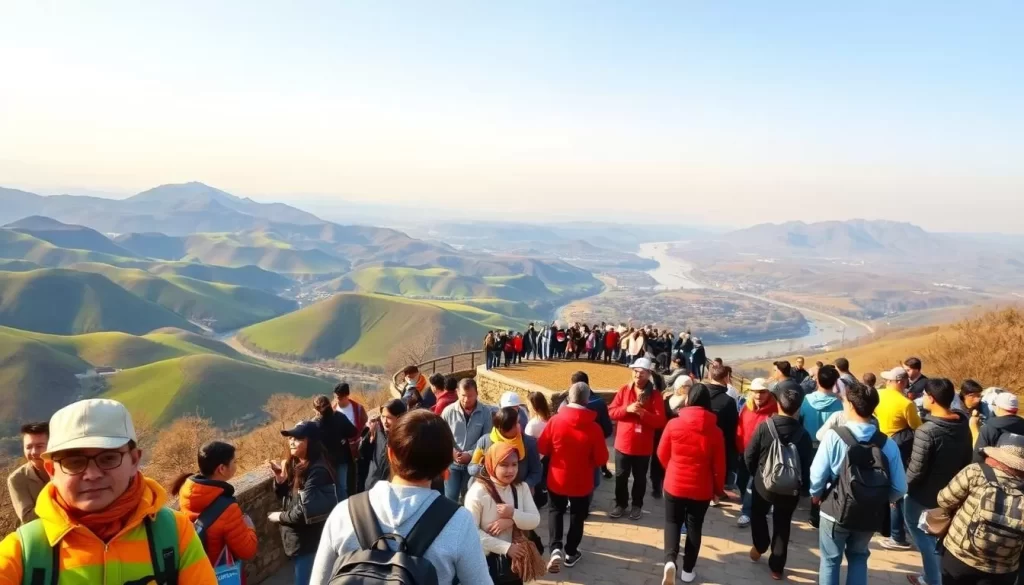
Managing Crowds and Peak Seasons
Peak tourist seasons often coincide with ideal weather, but they can also mean crowded scenic areas. For example, summer in popular destinations like Chengdu sees a surge in visitors, making it harder to enjoy attractions like the Giant Panda Breeding and Research Base.
Here are some tips to manage your itinerary during busy periods:
- Visit Early or Late: Arrive at popular sites early in the morning or late in the afternoon to avoid the midday rush.
- Explore Lesser-Known Spots: Discover hidden gems that are equally stunning but less crowded.
- Plan Ahead: Book tickets and accommodations in advance to secure your spot.
Benefits of Off-Peak Travel
Traveling during off-peak months offers a quieter and more personalized experience. You’ll have more space to enjoy breathtaking views and interact with locals without the hustle and bustle. For instance, visiting in late autumn or early winter allows you to explore scenic areas like Jiuzhaigou with fewer tourists.
Local Festivals and Events
Local festivals can add a unique dimension to your trip, but they also attract large crowds. Events like the Lhabab Duchen festival in November bring cultural richness but may require extra planning. Researching these events helps you decide whether to participate or avoid the crowds.
For updated information on tourist volumes and peak periods, check resources like . By considering these factors, you can craft a travel plan that maximizes your enjoyment and minimizes stress.
Comparing Sichuan’s Seasons with Other Regions of China
Understanding how seasons vary across different regions can help you plan a more enjoyable trip. Each area in the country has its own unique weather patterns, which can significantly impact your travel experience. By comparing these differences, you can make informed decisions about when and where to visit.
For example, the southern regions often experience warmer and more humid conditions year-round. In contrast, the northern areas tend to have colder winters and milder summers. This stark contrast means you’ll need to adjust your packing and activities based on your destination.
The valley landscapes in the south are lush and green, thanks to the subtropical climate. These areas are perfect for exploring vibrant flora and fauna. Meanwhile, the northern valleys often feature snow-capped peaks and alpine scenery, offering a completely different experience.
If you’re planning a trip between September and November, you’ll find this period particularly advantageous. The weather is mild, and the landscape is at its most vibrant. This is especially true in the central regions, where autumn foliage creates breathtaking views.
Here are some tips to consider when planning your itinerary:
- Check Regional Weather: Research the specific climate of your destination to pack appropriately.
- Plan Activities: Align your plans with the season to make the most of outdoor or indoor attractions.
- Visit During Off-Peak: Traveling between September and November often means fewer crowds and better deals.
Regional differences can also affect your overall experience. For instance, the southern areas are ideal for cultural tours and food exploration, while the north offers stunning natural beauty and winter sports. Understanding these variations helps you tailor your trip to your preferences.
For more insights on exploring the diverse landscapes and climates, check out this helpful guide. By considering these factors, you’ll be well-prepared to enjoy a seamless and memorable journey.
Maximizing Your Sichuan Adventure for the US Traveler
Traveling to a new destination offers endless possibilities, but smart planning ensures you make the most of your journey. For US travelers, understanding the time year to visit and how to navigate local customs can transform your trip into a seamless and enriching experience. This section provides actionable tips to help you save money, avoid crowds, and immerse yourself in the culture.
Budget Considerations and Off-Peak Deals
Traveling during off-peak periods can significantly reduce costs while offering a more relaxed experience. For example, visiting between September and November often means fewer tourists and better deals on accommodations and tours. This is the ideal time year to explore popular sites without the hustle and bustle.
Here are some budget-friendly tips:
- Book Early: Secure flights and hotels in advance to lock in lower prices.
- Leverage Discounts: Look for package deals or group tours that offer savings.
- Travel Midweek: Flights and accommodations are often cheaper outside of weekends.
“Traveling off-peak not only saves money but also allows you to connect more deeply with the local culture.”
Adapting to Local Cultural and Weather Conditions
Understanding local customs and weather patterns is key to a smooth trip. For instance, the rainy season can bring sudden showers, so packing a compact umbrella is essential. Similarly, learning a few basic phrases in the local language can go a long way in enhancing your interactions.
Here’s how to adapt:
- Dress Appropriately: Wear layers to adjust to changing temperatures throughout the day.
- Respect Local Customs: Research cultural norms to avoid unintentional faux pas.
- Plan for Weather: Check forecasts regularly and adjust your itinerary as needed.
| Travel Period | Benefits |
|---|---|
| Off-Peak (September-November) | Lower costs, fewer crowds, pleasant weather |
| Peak (Summer) | Vibrant festivals, longer daylight hours |
By planning your year visit strategically, you can enjoy a cost-effective and culturally rich adventure. Whether you’re exploring bustling markets or serene landscapes, these tips ensure a memorable journey.
Conclusion
Every journey becomes unforgettable when you align it with the right season and preparation. Choosing the ideal time to visit ensures you experience the best of the scenery and local culture. Whether you’re drawn to vibrant festivals or serene landscapes, thoughtful planning makes all the difference.
From packing light layers to exploring off-peak periods, these tips help every person enjoy their adventure. Tailor your itinerary to your preferences, and you’ll create memories that last a lifetime. For example, events like the Expo 2024 Chengdu showcase the region’s beauty and cultural richness.
With the right approach, every trip can be a kind of magic. Start planning today and discover the endless possibilities waiting for you!
The above is subject to change.
Check back often to TRAVEL.COM for the latest travel tips and deals.
